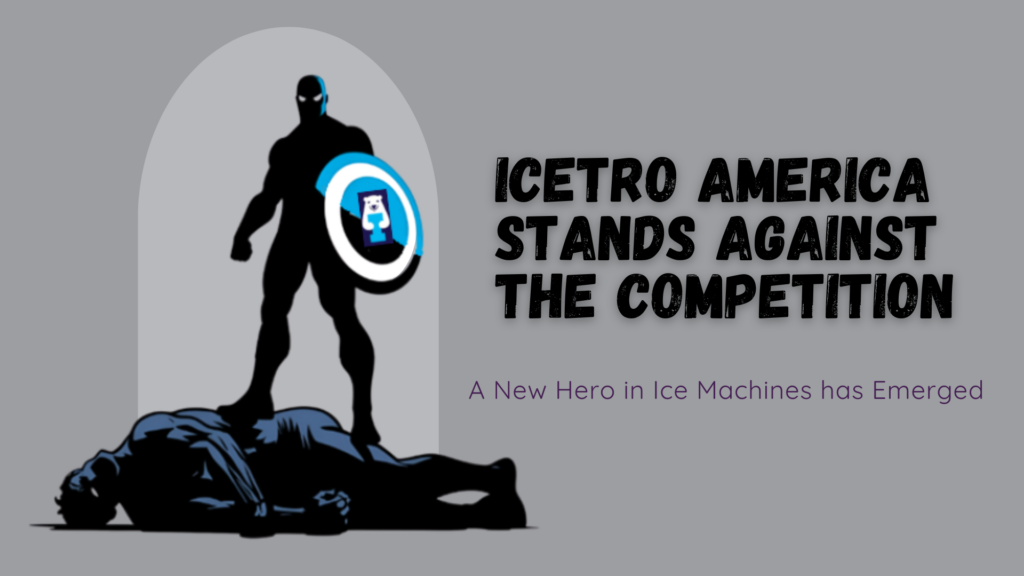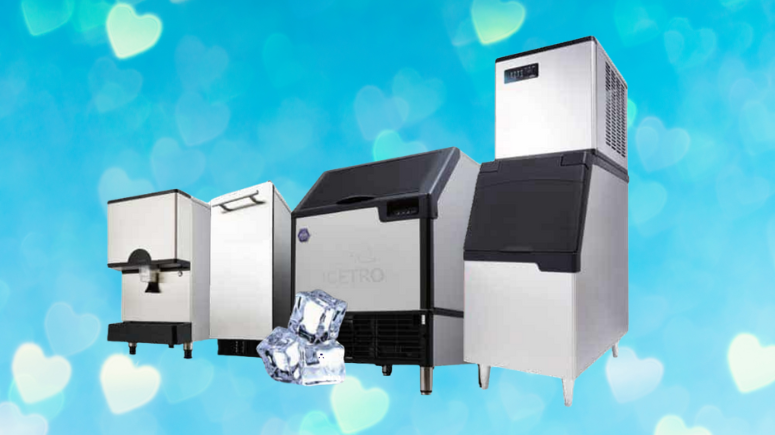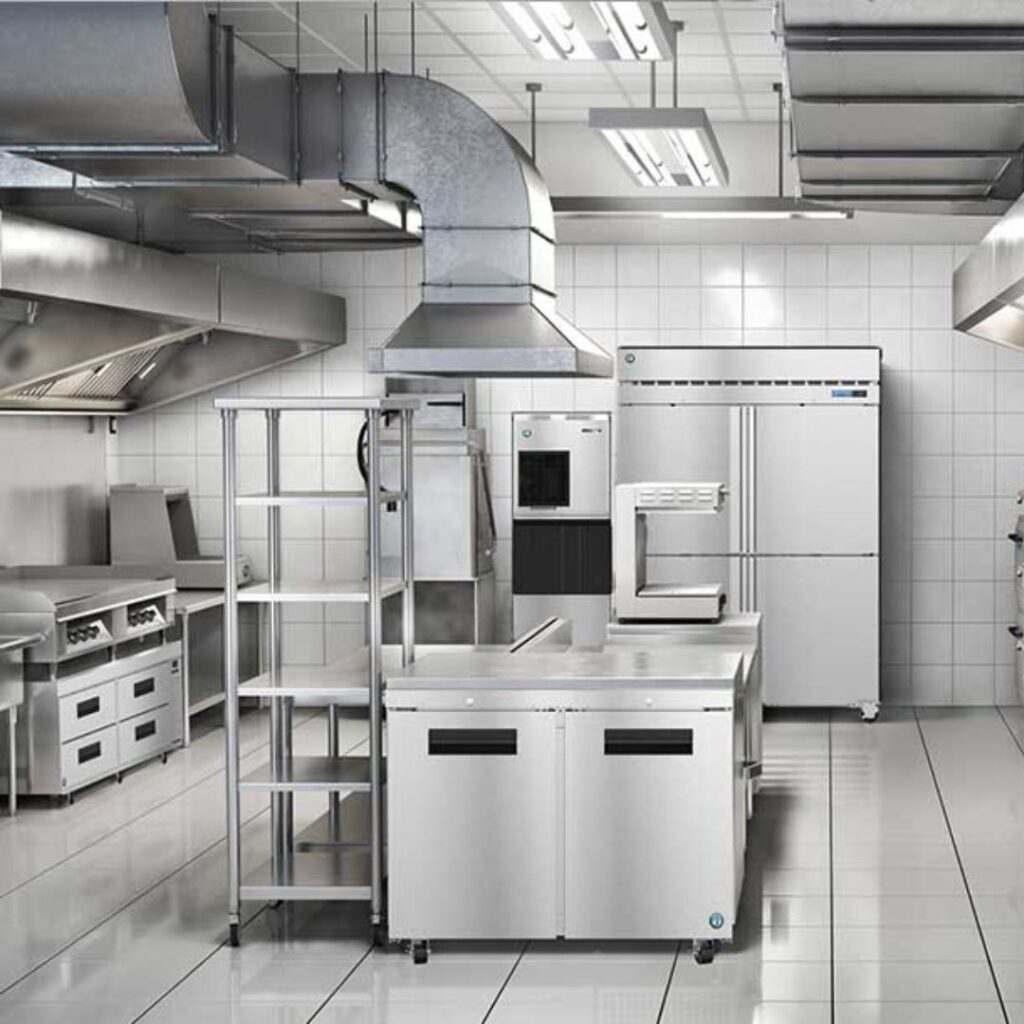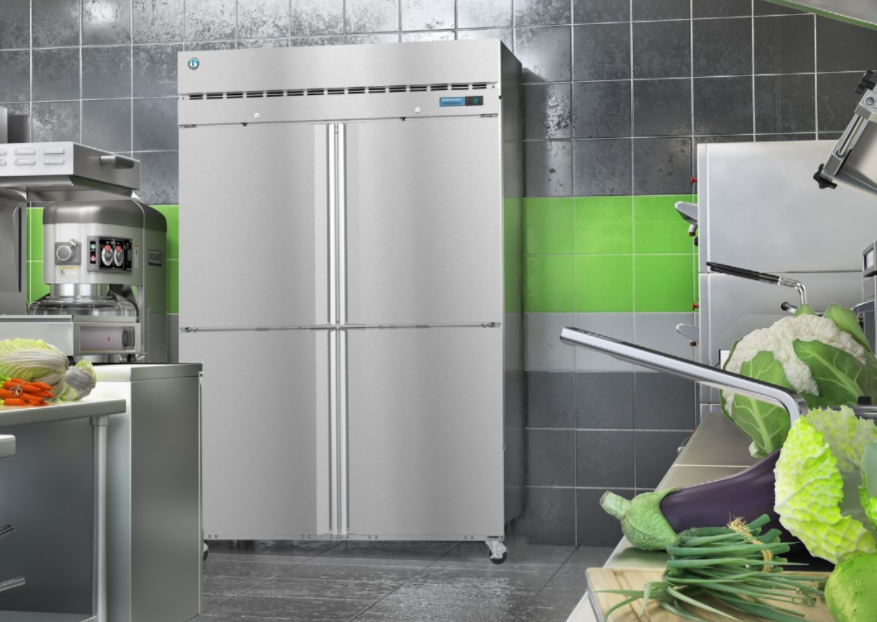Ice Machine Down? Refer to Win $

Suggest Icetro as an Ice Machine Replacement & Enter to Win Are you serving a customer who needs a new ice machine – either a first time user or to replace their old one? Icetro is a great option and retrofit. Recommend this globally proven machine to your customers and potentially put a little more cash in your pocket. How Icetro Ice Machine Features Compare » Ice Machine Pricing Comparison & ROI Analysis » How to Win?* It’s simple! Recommend an Icetro ice machine as a direct replacement to a previous brand’s model or as a new installation. Tell us about the referral by completing an entry form. The more referrals you make, the more entries you can earn. From the entries*, one will win a FREE $50 Visa Gift Card! Referral Entry Form *Completion of the form on this page or in person at the Ventana Distributing / Taylor Arizona Parts Store is required for entry to the Ice Machine Down Promotion (Promo). This Promo is open to all eligible technicians and staff of resellers, suppliers, retailers, etc. (Employees and family members of Ventana Distributing and its subsidiaries are not eligible). One referral per form. There is no limit on the number of referral entries that can be made per person (each must be for a different referral). Odds of winning are based on the number of submissions. Promo cannot be combined with any other promotions or offers (if you win and are eligible for more than one offer, you must select which you want to redeem). If a recipient declines the prize for any reason other than an alternate eligible promotion, they will not receive any substitution or reimbursement. Ventana Distributing in its in its sole and absolute discretion may opt to provide recipients with an alternate prize of equal or greater value. A winner will be drawn on July 16, 2025. They will be contacted directly and their name posted on social media.
The True Value of “Value Brands” in Commercial Kitchen Equipment

A Look at Commercial Ice Machine Pricing & ROI When outfitting a commercial kitchen, the most significant expense is acquiring food service preparation equipment. From ovens and refrigerators to commercial ice machines, these items are essential for smooth operation. However, with the rising costs of running a business, especially one serving food, the balance between quality and price becomes a critical decision. This is where value brands step in, providing an affordable yet reliable option for commercial kitchens. What Are Value Brands? A value brand is typically a product that provides the necessary quality and performance at a lower price point than premium brands. Note that, not all budget-friendly brands are the same! Some low-cost options offer great value —VALUE being the operative word—while others may be subpar—AKA: Cheap or missing critical functionality. These products usually have simplified features, fewer bells and whistles, and should focus on durability and reliability rather than advanced technology or brand prestige. This is why it’s important to do your research into features and global reputability, so you can get a true value brand and not a product you’ll regret after a few months or even a few days. Know what you’re really getting, who you’re buying from, and ensure the product meets your business’ needs. In a commercial kitchen, true value brands deliver the core functionality needed to keep operations running efficiently (both in daily production and low ongoing cleaning and maintenance) but without the hefty price tag associated with luxury or high-end models. For example, when selecting a commercial ice machine for a restaurant or bar, a business owner might opt for a value brand like Icetro America. Known for providing high-performance ice machines at an accessible price, Icetro America offers a perfect balance of cost-efficiency and reliability. The company doesn’t load its machines with extravagant features like checking ice production while the business is closed and the manager is home in bed, but who really needs to do that? It does offer automatic clean AND sanitization to keep the machine operational and hygienic day-in and day-out. Icetro ice machines deliver exactly what IS NEEDED: high-quality, long-lasting ice production. And because its design is focused on its application, it more easily fits focused budgets. That’s value. Commercial Ice Machine Pricing Comparison* For commercial ice machines, you can clearly see how Icetro compares as a lower-cost option against the competition (See chart below*). Icetro ice machines offer owners and operators up to over 30% savings!* AND these same, affordable*, Icetro ice machines, though basic in features, are genius in design—focused on what industrial kitchens need most to keep operating smoothly. See the Ice Machine Features Comparison >> The Benefits of Choosing a Value Brand for Your Commercial Kitchen Operating a commercial kitchen comes with its own unique challenges, especially when it comes to balancing quality and cost. When selecting high-use equipment—such as ice machines—making the right choice can significantly impact your bottom line. The right value brand can offer a powerful solution by delivering reliable performance at a fraction of the cost of premium brands. Here’s why choosing a true value brand can be one of the smartest decisions for your commercial kitchen: 1. Cost-Efficiency Without Compromise The most obvious benefit of choosing a value brand is the immediate cost savings. In a fast-paced foodservice environment, every dollar spent must be accounted for. Value brands allow businesses to secure high-quality equipment without the steep price tag often associated with premium models. Take, for example, an Icetro America commercial ice machine. It delivers consistent, high-quality ice production within the same footprint for a much lower price. Compare ice machine features and benefits to see what you’re getting for the price. 2. Flexibility for Your Budget and Business Needs Choosing a value brand provides greater flexibility with your budget. By investing in reliable yet cost-effective equipment, you can allocate funds to your priorities. If you are replacing an existing ice machine with an Icetro, you could get the same ice production at a lower cost or use the same cost and footprint to multiply production and accommodate growth. If you opt to save the difference, these savings can be redirected toward other priorities, such as daily operations, additional equipment, staffing and training, inventory, or marketing, all of which help drive the overall success of your business. The choice is yours on how “value” benefits your growing business model and needs. To achieve this autonomy, where you are choosing how to grow your business instead of allowing it to make demands of you, you have to remember that “value” doesn’t mean “cheap.” Otherwise, what you save today will be spent two-fold tomorrow. Buying a value brand should mean your ROI is faster and where you put it. Then, your product choices can give you budgetary freedom to help you remain agile and responsive in an industry that is constantly evolving. 3. Reliable, Day-to-Day Performance Value brands excel at stripping away non-essential features and focusing on what truly matters: core performance. You may not get all the bells and whistles, but the equipment will still perform reliably for everyday use. For example, a value commercial ice machine like those from Icetro America is durably built to withstand the demands of high-volume kitchens and bars. It provides a steady supply of ice, ensuring your operations run smoothly—even during peak hours. And to ensure that production stays flowing, its intentional design to keep cleaning and maintenance easy, saves time off hours and lowers service costs. Compare commercial ice machine manufacturers to see which have the built-in features your kitchen needs. This dependability is what makes value brands particularly attractive for businesses that need to keep the workflow uninterrupted. 4. Lower Maintenance Costs and Simplicity Another key advantage of value brands is their simplicity. Without extra features or complex technologies, value products tend to be easier to maintain and operate. This means less time spent on troubleshooting and fewer costly repairs over the life of the equipment. Because
Icetro America Stands Against the Competition

If you’re looking to compare commercial ice machines, the market is dominated by industry giants like Manitowoc, Hoshizaki, Ice-O-Matic, and Scotsman. However, Icetro America has emerged as a power-contender, offering superior design, durability, and value. But what really sets Icetro apart from the competition? Ventana Distributing compared commercial ice machines in a side-by-side review of their manufacturer features*—this way you clearly know what you’re getting for your money. *Please note, any data provided in this article is based on field observation and user-feedback, as well as online research available as of April 1, 2025. This article along with its comparisons and conclusions are the opinion of Ventana Distributing, a distributor of Icetro America products. Key Differentiators: Competitive Features The question of “Why choose Icetro?” is easily answered when reviewing this chart with all the features that matter to owners and operators. Icetro excels in the important areas of daily operation and ongoing practical maintenance where the competition falls short. Let’s look more closely at these features and what Icetro ice machines provide. Superior Design & Ease of Maintenance One of the primary concerns for businesses that rely on ice machines is ease of cleaning and maintenance. Unlike some competitors that require complex disassembly and specialized tools, or have inaccessible areas that breed bacteria and mold, Icetro ice machines are designed for quick and effortless cleaning and maintenance: Auto-Cleaning Feature: With the simple press of a button, Icetro machines initiate a full cleaning cycle, making routine maintenance hassle-free. Front-Access Cleaning & Service: Unlike other machines with an evaporator design, which requires cumbersome tools and brushes to clean, Icetro components are easily accessible for quick maintenance. Durable ABS Antimicrobial Interior: Quality ABS antimicrobial interior components, reduces slime buildup and enhances hygiene, keeping the ice machine cleaner for longer. Tool-Free Removal of Water Sump & Distributor Tube: Easy access to all parts of the machine that require cleaning and maintenance saves time and lowers service costs. Heavy-Duty Build & Longevity Icetro ice machines are engineered with longevity in mind. Here’s how the construction compares to the competition: 304 Stainless Steel Exterior: Unlike some competitors whose machines have painted side panels (you read that correctly), Icetro uses high-quality stainless steel for durability and corrosion resistance. Reinforced Components: Heavy-duty water curtain, pins, and hangers ensure long-term reliability. Non-Corrosive Base & Platform: Icetro machines are built to withstand tough commercial environments with their non-corrosive bases and platforms. Cost Savings & Competitive Pricing Investing in an ice machine is a long-term decision, and Icetro ensures that businesses get the best value for their money: Lower List Prices: Most Icetro machines cost less according to current published list prices. For example, a 350lb Icetro cuber (model IM-0350-AC/AH) is listed for 18% less than comparable machines offered by Hoshizaki and Manitowoc and 25% less than Scotsman. Some models see a differential of more than 30%! Free Freight on Multiple Units: Further reducing operational costs for distributors and business owners, Icetro offers free freight on orders of five ice machines or more (threshold for purchase must reach or exceed $20K). Free Initial Filter: Ventana Distributing is so confident in Icetro ice machines, they are currently offering a free initial filter with all machine purchases (valid through June 30, 2025). This is a $350-$550 immediate savings with a long-term benefit, as machines maintained with Icetro’s preferred filter are also eligible for an extension on the unit’s warranty. (Reading this after June 30, 2025? Contact Ventana Distributing for current promotional offerings.) Reliability & Customer Support A machine is only as good as the support behind it. Icetro America prioritizes customer satisfaction by providing: Excellent Warranty Coverage: Peace of mind is possible with warranty terms exceeding those of some competitors and an option for an extended warranty with recommended maintenance. Dedicated Technician Support Line: The dedicated technician support line offers fast and reliable assistance for troubleshooting and maintenance. Fair Compensation for Contractors: Unlike some brands that receive frequent complaints about warranty support due to a delay in technician compensation, Icetro ensures fair compensation for service providers, resulting in better customer service. After reviewing overall design, materials, ease of maintenance, longevity, sanitization, cost savings and customer support, Icetro simply offers a superior ice machine for better value. How Icetro Stacks Up Against Each Competitor You might already have a preferred ice machine manufacturer—one you’ve used for years. But if you’re honest, you know there are issues that cause your team frustration. We compared other commercial ice machine manufacturers head-to-head against Icetro. You may be shocked at where legacy brands fall short and how Icetro stacks. Icetro vs. Hoshizaki Hoshizaki’s newer evaporator design has faced reliability issues in the field and increased cleaning costs. Icetro addresses these concerns with: Simple Cleaning & Maintenance: No need for long brushes or difficult-to-access components Adjustable Water Flush Time: Ideal for areas with hard water, reducing scale buildup Better Price-to-Performance Ratio: Lower operational costs with similar or superior ice production Icetro vs. Ice-O-Matic & Scotsman Both Ice-O-Matic and Scotsman utilize a grid cell design with a push probe to harvest ice, which can lead to 1) plating & solder joint failures due to added pressure on the evaporator surface, 2) higher evaporator failure rates resulting in increased downtime and repair costs, and 3) a reputation for poor quality & warranty issues. Icetro addresses these concerns with: Reliable Evaporator Technology: Minimizing mechanical failure risks Strong Warranty & Service Network: Ensuring better customer satisfaction Competitive Pricing: Delivering better cost savings per unit Icetro vs. Manitowoc Manitowoc machines have elicited user-concerns due to hot gas issues and durability, with no standard cleaning AND sanitization function the machines often require a lot of time and effort to fully manually, and their pricing isn’t as good as it first looks. Icetro addresses these concerns with: Enhanced Durability: Icetro uses high-quality stainless-steel exteriors and reinforced internal components using a robust supply chain network to ensure longer-lasting high performance Easy Cleaning & Maintenance: Auto-cleaning function also sanitizes and front-access design streamlines maintenance Pricing &
Why Choose an Icetro Ice Machine

Icetro: The Ideal Ice Machine For businesses that depend on a steady supply of ice, choosing the right ice machine is a crucial decision. Ventana Distributing chose to carry Icetro America ice machines because they consistently deliver a reliable supply of quality ice and have established themselves as a leader in the industry, delivering cutting-edge design, superior performance, and long-term reliability, all at a stellar price! Here are some of the reasons you should consider Icetro ice machines for your next installation. Unparalleled Ice Quality Ice is more than just frozen water; in many industries, it plays a crucial role in customer satisfaction and product preservation. Icetro ice machines are engineered to produce high-quality ice with optimal clarity and density. Whether a business requires cubed ice, nugget ice, or flake ice, Icetro offers models that deliver uniform, high-quality results every time. This consistency is particularly beneficial for food service establishments, where ice clarity and shape can influence the presentation of beverages and dishes. Easy to Keep Clean Icetro prioritizes hygiene in ice production. It is critical that ice machines remain clean for obvious reasons. Sanitation is often a shortcoming for many machines on the market. This is where Icetro excels and provides peace of mind. Inside, components such as the water curtain, pump, water trough, and float switch are removable by hand—no tools required. This simplifies routine cleaning and reduces downtime. Additionally, the use of ABS antimicrobial plastic parts ensures a non-corrosive base to maximize cleanliness. Icetro ice machines are equipped with a user-friendly electrostatic air filter, which is magnetically attached for quick removal and easy cleaning. This feature helps maintain optimal airflow and efficiency while reducing energy consumption. An automatic cleaning cycle, activated by a simple switch, further enhances the ease of maintenance, ensuring that ice production remains uninterrupted and hygienic. Performance Icetro ice machines are designed to minimize downtime and deliver maximum production in all conditions. The machines are built to withstand high-demand environments, ensuring a consistent supply of ice even in peak usage periods. Advanced cooling technology optimizes efficiency, preventing overheating and maintaining optimal ice production rates. Additionally, these machines show excellent energy efficiency and noise reduction as part of their performance differentiators. The unique three-way ventilation system that exhausts air from the sides and top panels, airflow is optimized to maintain consistent cooling while minimizing operational noise. This feature makes Icetro machines ideal for environments where noise levels need to be kept at a minimum. Whether in a busy restaurant, hotel, or healthcare facility, Icetro machines provide reliable and high-performance operation. Easy to Maintain And while consistent performance is critical, so is the ease of necessary maintenance to ensure it. Icetro machines are designed with accessibility in mind, ensuring that regular operations, cleaning, and maintenance are seamless so that daily performance remains unhindered. The intuitive diagnostic panel provides real-time operating status and basic controls, making it easy to monitor and manage the machine’s performance. A hinged front panel allows for quick and effortless access for cleaning and inspection. When deeper maintenance is required, both the front and side panels can be easily removed, ensuring complete access to internal components. Durable & Dependable To be a workhorse ice machine, durability in design is essential. Stainless steel exterior panels provide longevity while maintaining a sleek and professional appearance. The ABS antimicrobial plastic is made of thick, high-strength components intended for endurance. Putting their commitment to precision manufacturing to the test, each unit undergoes rigorous quality control, completing three full cycles at the factory in South Korea before being shipped. This ensures that every machine meets the highest standards of quality, serviceability, and performance to minimize downtime while maximizing ice production. Icetro ice machines stand out for their advanced features that enhance efficiency and longevity. Adjustable water flush settings accommodate hard water conditions, minimizing scale buildup and extending the time between cleanings. A magnetic switch automatically halts ice production when the bin is full, preventing unnecessary strain on the machine. Additionally, its proprietary IcePro Citryne filter solution further extends the lifespan of the unit, adding an extra year of warranty coverage when used correctly. Exceptional Customer Support and Warranty Coverage Beyond superior engineering, Icetro America takes pride in providing outstanding customer support. The company offers a comprehensive warranty program, ensuring that customers receive assistance when needed. From troubleshooting support to replacement parts availability, Icetro prioritizes customer satisfaction at every step. Icetro also maintains a network of trained technicians and service providers, ensuring that businesses receive prompt and professional support whenever an issue arises. Unlike some manufacturers that rely on limited service networks, Icetro commitment to fair compensation for contractors means that businesses can expect high-quality service without excessive delays. Cost-Effective Icetro ice machines provide exceptional performance while maintaining affordability. Their pricing structure allows businesses to acquire high-quality equipment without excessive costs. And reliability and cost-effectiveness go hand in hand with Icetro. The long-term cost of owning any ice machine extends beyond the initial purchase price, encompassing operational efficiency, cleaning and sanitation, filtration, and maintenance. Icetro machines are designed to minimize these expenses by incorporating innovative features that reduce the need for frequent servicing and repairs. The heavy-duty water curtain, reinforced pins, and durable hangers ensure continued performance, even in high-demand environments. Icetro is the economical choice for businesses looking to maximize value without sacrificing quality. A Legacy of Excellence in Ice Machine Manufacturing Icetro has been a trusted name in ice-making technology for decades. Now, as a Middleby Company, it further underscores its dedication to quality and innovation. As part of a globally recognized brand in the food service equipment industry, Icetro upholds its tradition of excellence by delivering state-of-the-art ice-making solutions that prioritize performance, reliability, and ease of use. The brand continues to evolve to meet the needs of modern businesses. For businesses seeking an ice machine that delivers exceptional value, longevity, and hassle-free operation, Icetro remains the clear choice. With its superior construction, thoughtful design, and commitment to customer satisfaction, Icetro ice machines set the
Filter the Fuss: Limited Time Free Filter Offer

Buy the Ice Machine, Get the Filter for Free Now, is the perfect time to discover the amazing value of Icetro Ice Machines. Ventana Distributing is offering the first filter free when you buy any ice machine through June 30th. And there is no limit! Buy 10 cubers and get all 10 complimentary filters. Save you and your customers money in more ways than one with these work-horse ice machines. How Can I Get My Free Filters? This promotion is open to all eligible purchasers. To receive your free filter with any ice machine purchase, simply complete the form at the bottom of this page (required) and purchase an Icetro America Ice Machine from Ventana Distributing by June 30, 2025. Corresponding filters to each Icetro ice machine purchased between April 21 – June 30, 2025 will automatically be supplied at no additional cost to purchasers who have also completed the form at the bottom of this page. Which Filter Will I Receive? Icetro America utilizes IcePro water treatment systems in providing pre-filtration to all systems as well as controlling scales with a patent blend called Citryne. The IcePro series is a complete system without the need to add additional pre-filtration or scale control. The filter you are provided will be the appropriately sized model to fit the ice machine ordered. The value of the filter varies based on its size in correlation to the ice machine—typically $300.00 – $500.00. Consistent use of Icetro’s preferred filters ALSO adds an additional year to the machine’s warranty and provides protection against scale build-up. Complete This Form to be Eligible for Your Free Ice Machine Filter(s)
Ventana Distributing Expands Product Line to Include Icetro America Ice Machines

A Partnership to Bring Quality & Affordable Ice Machines to Arizona FOR IMMEDIATE RELEASE Jan. 14, 2025, PHOENIX – Ventana Distributing, a regional supplier of commercial foodservice equipment, has announced a new distribution partnership with Icetro America, a Middleby brand, to bring reliable, cost-effective and hygienic ice machines to Arizona. Icetro America manufactures durable and efficient ice machines designed for a wide range of commercial environments, including restaurants, hotels and healthcare facilities. The company is recognized in the industry for combining dependable performance with accessible pricing. “We’re excited to now offer Icetro’s impressive lineup of ice machines to our customers,” said Paul Hodges, president and managing partner of Ventana Distributing. “We’re once again empowering them with smart solutions that help them serve cleaner, operate more efficiently and spend less.” Effective immediately, Ventana will offer Icetro’s ice machines and bins — including cube, nugget and flake models — across its distribution territory. For product inquiries or ordering information, contact Ventana Distributing at [email protected]. About Ventana Distributing Ventana Distributing is a Phoenix-based distributor of commercial foodservice equipment, serving dealers, suppliers and technicians throughout the Southwestern United States. The company is known for its knowledgeable support and reliable inventory across a curated portfolio of equipment manufacturers. https://www.ventanadistributing.com About Icetro America Icetro America has been a global manufacturer of commercial foodservice equipment since its founding in 1981. The company is known for its ice cube machines, soft serve ice cream machines, slush machines and ice/water dispensers. https://icetroamerica.com Media Contact Matt Carosi Director of Business Development 602-268-3386 [email protected] https://www.ventanadistributing.com ###
The Importance of Ice in Crafting Cocktails

Enhancing Flavor and Presentation When it comes to having a refreshing, relaxing cocktail, what’s the first thing that comes to mind? Perhaps it’s the mix of spirit, the burst of fresh flavors and ingredients, or the expertly garnished glassware. While each element is crucial in crafting a spectacular cocktail, there is one ingredient that often goes unnoticed. Some say it is the most vital element in the perfect cocktail—the ice. In this article, let’s delve into the world of ice in cocktail making. From its history to the science behind the cube, you will gain a newfound appreciation for this often-overlooked element that elevates your cocktail experience. A Look Back in Time The usage of ice in cocktails dates back centuries. In the early 19th century, ice became more accessible due to technological advancements in ice harvesting and storage. It was during this time that cocktails started to gain popularity. Jerry Thomas, often referred as the “father of American mixology,” made significant contributions to the cocktail world during his time. In his book, “The Bartender’s Guide,” published in 1862, featured numerous cocktail recipes that called for ice. Not only was ice used for chilling drinks, but Thomas also recognized its purpose in dilution and flavor balancing. Ice Science Let’s breakdown the science of ice, it is no secret, ice is simply frozen water. But it’s more complex than just that. At a molecular level water molecules arrange themselves in a hexagonal lattice when frozen. This arrangement creates a solid structure with open spaces. The most vital property of ice in cocktails is its ability to regulate temperature through heat exchange. When ice is added to a cocktail shaker or glass, it absorbs heat from the surrounding liquids, causing it to melt. This process is crucial for achieving the desired temperature and dilution in cocktails. Ice Forms and Their Uses Not all ice is created equal, and bartenders have long recognized the importance of using the right ice type for different purposes. See below for a list of Hoshizaki’s specialty ice and their uses. Sphere Ice Sphere ice, also known as ice balls or ice spheres, is the perfect ice cube shape for bourbon, scotch, and whiskey. Unlike traditional ice cubes, which have a low surface area-to-volume ratio and melt quickly, sphere ice has a low surface area-to-volume ratio, which means sit melts more slowly. 1BY1 Ice Similar to sphere ice, 1by1 ice melts slowly. They are the ideal ice cube for stirred cocktails where you want a little ice but don’t want to water it down too much, like a Negroni or an Old Fashioned. 2BY2 Ice A 2by2 ice cube gives cocktails and spirits a glam look while maintaining a superior cocktail chill with minimal dilution. Increasing flavor and presentation of specialty cocktails or straight spirits like bourbon or scotch Ice’s Role in Cocktails Now, let’s dive into the various roles ice plays in crafting the perfect libation: Temperature Control One of the primary functions of ice is to chill cocktails to the desired temperature. A well-chilled cocktail is not only more refreshing, but also allows the flavors to shine. Ice achieves this by absorbing heat from the liquid, lowering its temperature. Dilution Dilution is a critical aspect of cocktails balance. It involves adding water to the drink, which can help mellow the intensity of spirit and enhance the overall flavor. Ice contributes to dilution as it melts. The rate of dilution can be controlled by choosing the right ice type. Visual Presentation Presentation matters in the world of cocktail. Clear and creatively shaped ice adds visual appeal to drinks, making them more enticing. It’s no secret that we often drink with our eyes first. Maintaining Consistency Bartenders rely on ice to maintain consistency in cocktail preparation. By following established recipes and using standardized ice forms, they can ensure that each drink meets customers’ expectations. Conclusion As simple as it is, ice truly can make or break a good cocktail. While it is not the focal point of the drink, you certainly can’t go without it. When used thoughtfully, it can transform a good drink into a great one.
The Importance of Commercial Refrigerators in the Food Industry

The Importance of Commercial Refrigerators in the Food Industry Commercial refrigerators are an essential equipment in the food industry. They are used to store and preserve food products at safe temperatures, keeping them fresh and safe for consumption. Whether running a small bakery or a large restaurant, a commercial refrigerator is a crucial investment to ensure the quality of your food products. In this context, we will explore the different types of commercial refrigerators, their features and why they are crucial for business in the food industry. Types of Commercial Refrigerators Several types of commercial refrigeration are available in the market, each with unique features & benefits. The most common types of commercial refrigerators are: Reach-In Refrigerators: These are the most popular commercial fridges, commonly found in restaurants, cafeterias, and catering businesses. They are designed to be used in kitchens and provide easy access to stored food items. Under counter fridge freezers: as the name suggests, these refrigerators are designed to fit under counters or worktables, making them ideal for small kitchens with limited space. Walk-In Freezers: Large freezers allow people to walk in and out of them. They are commonly used in large-scale food businesses such as restaurants, hotels, and catering companies. Merchandise Refrigerators: These refrigerators are designed to showcase food products such as desserts, sandwiches, and beverages. They are commonly used in cafes, convenience stores, and supermarkets. Features of Commercial Refrigerators Commercial refrigerators have various features that make them ideal for storing food products. Some of them most common features include: Temperature Control: Commercial fridge freezers have temperature control features that allow businesses to adjust the temperature according to their needs. This is crucial in ensuring food products are stored at safe temperatures, preventing spoilage and contamination. Energy Efficiency: Many commercial refrigerators are designed to be energy-efficient, helping businesses save their energy bills while still maintaining storage temperatures. Durability: Commercial fridges are designed to be durable & withstand the rigors of daily use in busy kitchens. Easy Maintenance: Most commercial freezers are designed with easy-to-clean surfaces and removable parts, making maintenance, and cleaning a breeze. Why are Commercial Refrigerators Important in the Food Industry? Commercial refrigeration is essential in the food industry for many reasons. Continue reading for reasons why companies in the food industry rely on refrigerators. Food Safety: refrigerators are critical in ensuring food products are stored at safe temperatures, preventing spoilage and contamination. This is especially important for businesses that handle perishable food products such as meat, dairy, and produce. Cost Saving: Investing in high-quality refrigeration can help businesses save on energy bills and reduce food waste. By maintaining safe storage temperatures, businesses can reduce risk of spoilage & extend the shelf life of their food products. Compliance: The food industry is highly regulated, with strict food safety & storage guidelines. Freezers are designed to meet these regulations, helping businesses comply with food safety standards and avoid penalties. Product Quality: Fridges help businesses maintain the quality of food products, ensuring they are fresh and delicious when served to customers. This is crucial for businesses that rely on the quality of their food products to build a loyal customer base. Conclusion Commercial refrigerators are an essential investment for businesses in the food industry. They play a critical role in ensuring food safety, reducing costs, complying with regulations, and maintaining the quality of food products. Whether you are running a small bakery or a large restaurant investing in high-quality commercial refrigeration is a must to ensure the success and longevity of your business. When choosing a commercial fridge, it is essential to consider your specific needs and features that will best meet them. Look for a reputable manufacturer and supplier that can provide quality products and reliable support. By investing in a commercial freezer, you are investing in the safety and success of your business in the food industry.
Manufacturer vs Distributor – Understanding the Core Differences

In the world of commerce, the supply chain has two vital components: manufacturers and their distributors. Each operate at distinct points in the path to purchase to their consumers. Manufacturers: Turning Dreams into Reality Manufacturers are the creators of products, building things from raw materials. Through advanced technology and skilled workers to build from the ground up. These individuals bring ideas to life by creating everyday items that are in high demand for the consumer’s use. With the Hussle and Bussel of production lines raw materials are meticulously shaped, assembled, and refined into the finished product. In the United States alone, 12.5 million people work in manufacturing. Key Characteristics of Manufacturers: Creation & Innovation: Manufacturers conceptualize products, design prototypes, and engineer processes to produce goods on a large scale. Quality Control: Manufacturers have a system in place to maintain quality standards, ensuring every item leaving their facilities meets their predetermined specifications. Customization & Specialization: Manufacturers tailor their products based on their client’s market requirements, offering diverse customized solutions. Research & Development: Manufacturers invest heavily into research and design to enhance existing products, innovate new ones, and stay ahead of the competition. Distributors: The Connectors in the Supply Chain Distributors play a critical role in the industry by connecting manufacturers and resellers. They purchase products in large amounts from manufacturers and sell them in smaller quantities to resellers. This aids in streamlining products from makers to sellers. Distributors serve as the local hub for their resellers, storing products, managing inventory, and coordinating the efficiency of goods to meet the market demands. Key Characteristics of Distributors: Market Expertise: insights into market trends, consumer behavior, and demands. Enabling them to make informed purchasing decisions. Logistics & Storage: infrastructure for warehousing, ensuring safe storage and streamlined distribution of diverse products. Relationship Management: cultivate relationships with manufacturers, resellers, and the end user. Facilitating seamless communication and collaboration. Risk Mitigation: mitigate risk by diversifying their product portfolios, adapting to market changes, and proper inventory management to prevent overstocking or shortages. Distinguishing Factors: Distributor vs Manufacturer Production vs Aggregation: The main distinction is within their core functions. Manufacturers focus mainly on production, where distributors aggregate products from various sources. Ownership of Production: Manufacturers own the production process, overseeing each stage of production. Distributors do not produce the goods; they acquire them from the manufacturers for distribution. Scale of Operation: Manufacturers operate on a large scale, with large facilities and a workforce dedicated to production. Distributors optimize efficiency in logistics and storage to handle a wide variety of products efficiently. Direct vs Indirect Interaction: Manufacturers deal directly with the raw materials, turning them into the finished product. Distributors serve as the intermediate facilitating the movement of goods to the end user. Conclusion As we mentioned in the beginning of the article, the supply chain has two vital components in the world of commerce: manufacturers, and their distributors. The key to any successful business and customer relations is for both to work seamlessly to deliver both product and value to the end user.
